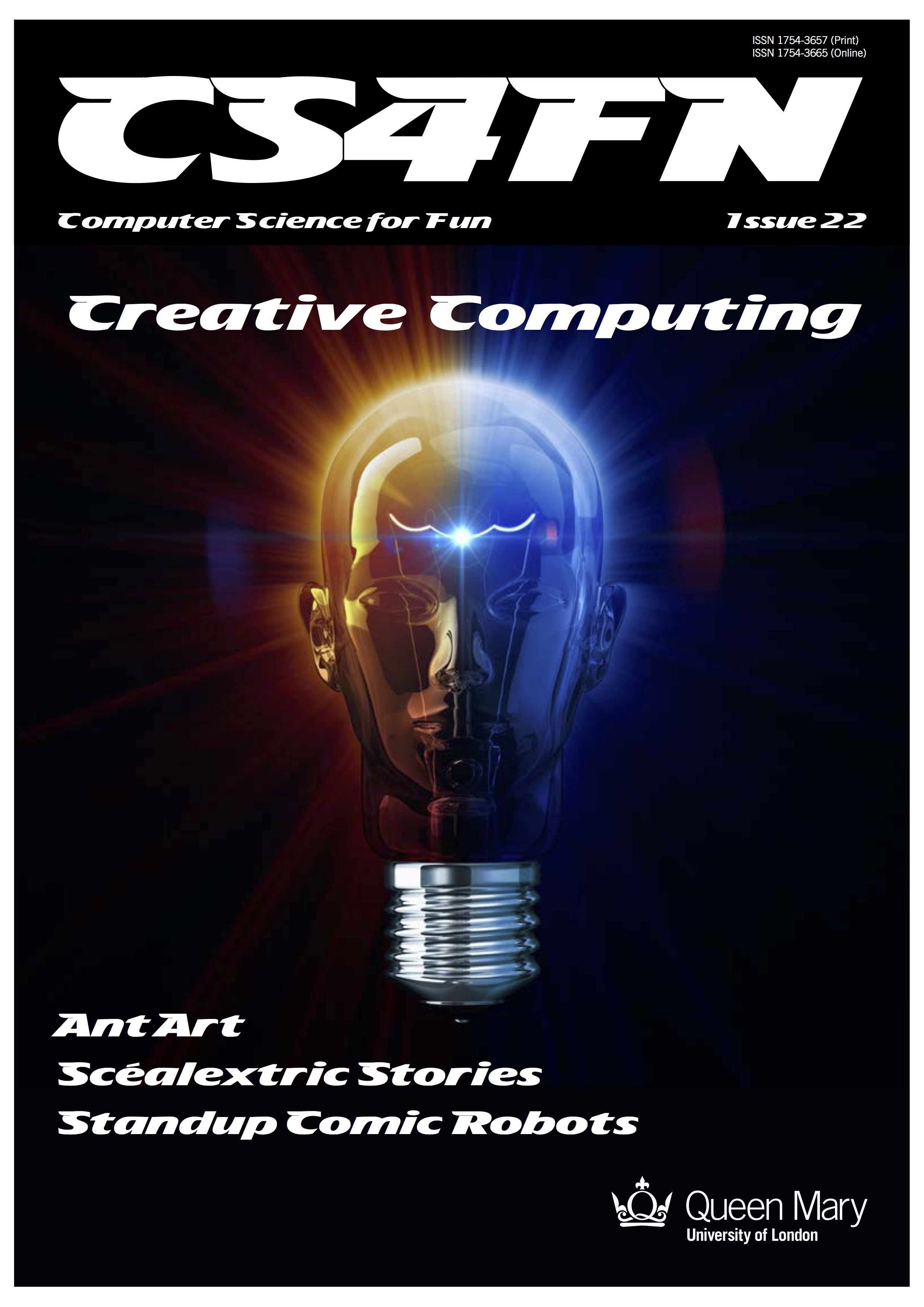In a previous post http://compuationalthinking.blogspot.co.uk/2016/11/artificial-neuron-in-scratch.html I used Scratch to build a working artificial neuron.
In this post, the training of a neuron all written in Scratch is tackled. The video shows it action and you can have a go at using the software yourself at the end of the post. The Scratch code can be found at https://scratch.mit.edu/projects/132915502/
All views are those of the author and should not be seen as the views of any organisation the author is associated with.
A blog concerned with computational thinking at all levels; problem-solving and creativity in computing.
Monday 28 November 2016
Saturday 26 November 2016
Computer Science for Fun - cs4fn: cs4fn Magazine+: Issue 22 Creative Computing
Computer Science for Fun - cs4fn: cs4fn Magazine+: Issue 22 Creative Computing:
cs4fn Magazine+: Issue 22: Computing Sounds Wild
ISSN 1754-3657 (Print)
ISSN 1754-3665 (Online)
A pdf is available to download for free from our download site.
Tuesday 22 November 2016
Artificial Neuron in Scratch
Instructions:
- Set the inputs by pressing the buttons marked input 1 and input 2 (Red is off(False or 0) and Green is on(True or 1))
- Change the weights by changing weights 1 to 3, wx goes with input x and weight 3 is the bias.
- To activate the neuron you need to click on the the yellow ball ('the neuron').
The video below show it in action and explains the code.
All views are those of the author and should not be seen as the views of any organisation the author is associated with.
Sunday 6 November 2016
How to be an Unplugged Artist
Original post at: https://computingnorthampton.blogspot.co.uk/2016/11/how-to-be-unplugged-artist.html
Ok, confession time. I co-wrote, along with Katharine Childs (Code Club), Chapter 3 Artists so I am biased here, but I believe in the central theme of Unplugged Computing. Computing, and Computational Thinking in general, is not just about programming and using a computer (though using computers and programming are vitally important to Computing) but it is also about many other things including problem-solving, being creative and working collaboratively.
Chapter 3 is about linking these computational thinking ideas to produce visual art, by applying computing principles including repetition, following and refining algorithms, and abstraction. The chapter also looks, how these links have already being made, with examples such Sol Le Witt where not all the work that was produced by the artist himself, but some by others following his written instructions - in other words an algorithm. There is even a game Thomas's Tangles
The other chapters make links with areas such as Robots, Musicians, Explorers, Magicians, Gamers, Cooks and Scientists.
References
| Barr, D., Harrion, J., and Conery, L. (2011) Computational Thinking: A Digital Age Skill for Everyone Leading and Learning with Technology, ISTE, March/April 2011 [accessed via http://www.csta.acm.org/Curriculum/sub/CurrFiles/LLCTArticle.pdf on 26/12/2015] | ||||
| Barr, V. and Stephenson, C. (2011) Bringing Computational Thinking to K-12, ACM Inroads, Vol 2. No 1, pp 48 - 54 [accessed via http://csta.acm.org/Curriculum/sub/CurrFiles/BarrStephensonInroadsArticle.pdf on 26/12/2015] https://doi.org/10.1145/1929887.1929905 | ||||
| Computing at School (2013) Computing in the National Curriculum: A guide for primary teachers [accessed via http://www.computingatschool.org.uk/data/uploads/CASPrimaryComputing.pdf on 13/3/2016] | ||||
| Denning, Peter J. (2009) Beyond Computational Thinking, Communications of the ACM Vol 52, Issue 6, pp 28 - 30 [accessed via http://sgd.cs.colorado.edu/wiki/images/7/71/Denning.pdf on 26/12/2015] | ||||
| DfE: Department for Education (2013) National Curriculum in England: computing programmes of study | ||||
| Freedman, J. (2015) Cycloid Drawing Machine [online] URL: https://www.kickstarter.com/projects/1765367532/cycloid-drawing-machine accessed on 3/3/2016. | ||||
| Google. 2016 Project Jacquard [online] URL: https://www.google.com/atap/project-jacquard/ accesed on:1/3/2016. | ||||
| Knuth, D. 1968. Preface, The Art of Programming vol 1., Boston: Addison-Wesley. | ||||
| Knuth, D. 1996. Foreword. In: Petkovsek, M., Wilf, H., Zeilberger, D. A=B.. Natick: A K Peters/CRC Press, vii. | ||||
| Koetsier, T., 2001. On the prehistory of programmable machines: Musical automata, looms, calculators. Mechanism and Machine Theory, 36(5), 589-603. https://doi.org/10.1016/S0094-114X(01)00005-2 | ||||
| Menegus, B (2016) CDMS: Built with Processing [online] URL: http://wheelof.com/sketch/ accessed on 4/3/2016 | ||||
| MoMA. 2012. MoMA| Video Games [online] URL: http://www.moma.org/explore/inside_out/2012/11/29/video-games-14-in-the-collection-for-starters/ accessed on: 1/3/2016. | ||||
| Papert, S (1993) The children's machine: Rethinking schools in the age of the computer. New York: Basic books | ||||
| Pearson M (2011) Generative Art: A practical guide using Processing, New York: Manning, 3-12 | ||||
| Selby, C. and Woollard, J. (2013) Computational thinking: the developing definition University of Southampton [accessed via http://eprints.soton.ac.uk/356481/7/Selby_Woollard_bg_soton_eprints.pdf on 26/12/2015] | ||||
| The Art Story (2016) Sol LeWitt [online] http://www.theartstory.org/artist-lewitt-sol.htm accessed on: 6/3/2016 | ||||
| Wing, J. (2006) Computational Thinking Communications of the ACM Vol 49 pp 33 - 35 [accessed via https://www.cs.cmu.edu/~15110-s13/Wing06-ct.pdf on 26/12/2015] https://doi.org/10.1145/1118178.1118215 | ||||
| Wing, J. (2011) Computational Thinking - What and Why The Link - News from the School of Computer Science, Issue 6.0, Spring 2011 [accessed via http://www.cs.cmu.edu/sites/default/files/11-399_The_Link_Newsletter-3.pdf on 26/12/2015] | ||||
| Liukas L (2015) Activity 7 The Robots Hello Ruby - Adventures in Coding, New York: Feiwel and Friends, 94-97. | ||||
| Schofield, S (2016) Generative Artworks [online] URL: http://www.simonschofield.net | ||||
| Turner S (2016) 3 'Art' Scratch Projects [online] URL: http://compuationalthinking.blogspot.co.uk/2016/03/3-of-my-scratch-projects-for-week.html accessed on: 12/3/2016. | ||||
All views and opinions are the author's and do not necessarily reflected those of any organisation they are associated with. Twitter: @scottturneruonAll views are those of the author and should not be seen as the views of any organisation the author is associated with.
Subscribe to:
Posts (Atom)
Answers not on the Screen
2. The answers not on the screen Hill, G. , Turner, S. J. and Childs, K. (2017) Abstract: Reflection from two areas on the issues...

